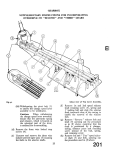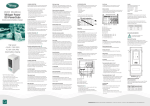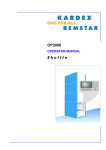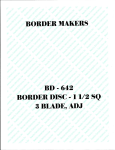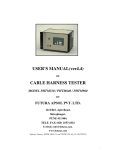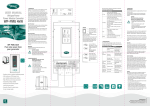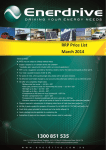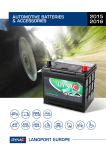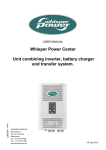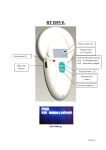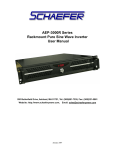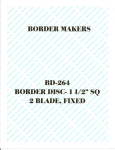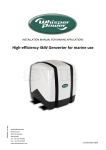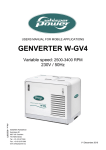Download : whisper power - Lichtmaschine 12 V / 90 A, at www.SVB.de
Transcript
5 4 3 2 Maintenance and repair Use only original spare parts. 1. INTRODUCTION Thank you for choosing a professional quality product from WhiperPower. WP-DC Beltpower is a system designed to be driven by a belt from a pulley on a vehicle’s or ship’s propulsion engine. In most cases an additional pulley has to be installed. The alternator’s output is connected to the WP-ACR, which converts and regulates the incoming alternating current in order to charge a 12 or 24 Volts battery bank using a state-of-the-art charge algorithm. 1 A WP-DC WhisperPower DC Beltpower 12/90 12/130 12/160 24/75 24/110 24/150 CAUTION ! When service has to be carried out while the engine is running, be aware of moving parts ! C Problem WARNING ! B Make sure the WP-DC Beltpower and engine are sescured against unexpected and unintentional switching on when switched off for maintenance or repair. -Remove the key from the engine ignition switch; -Disconnect the batteries or remove the5DC fuse(s); 4 -Be sure that third parties cannot reverse the measures taken. This manual is valid for the following products: Part number 60212091 60212131 60212161 60115100 60224076 60224111 60224151 60115200 Discription WP-DC Beltpower 12V/90A Alternator WP-DC Beltpower 12V/130A Alternator WP-DC Beltpower 12V/160A Alternator WP-ACR 12V Alternator Charge Regulator WP-DC Beltpower 24V/75A Alternator WP-DC Beltpower 24V/110A Alternator WP-DC Beltpower 24V/150A Alternator WP-ACR 24V Alternator Charge Regulator D C 1 2 3 Electrical connections: - Check the wiring at least every six months. Burned cables, poor connections etc. must be corrected immediately. DC A3 D Monitoring and control Refer to Figure 1: the battery charging performance can be monitored by means of the WP-ACR display. E SHEET IPE CE PRINC TOLERAN 15 ISO 80 IFIED: ISE SPEC ANGLE THIRD OTHERW : S S N : GE LES TIO UN ARP ED Material PROJEC FER SH AM CE mm : CH AN UNITS L TOLER GENERA 68-m CES 27 LERAN TO E NEN ISO AC AND PL FORM 22553 1101 NEN EN NEN-ISO 4 SYMBOL NEN363 STATUS: WELDING DATE ACC. to HNESS TURE ROUG SIGNA 3-9-2014 ME NA 14 -20 -05 19 ING: J.M. DRAW N 838 DRAW 5014A12 M.B. CHK'D ARTICLE 91 SHEET 1 OF 1 No output power, one of the LEDs is on. B [field] on WPACR is 0V. :1 SCALE:1 104,08 248,20 248,20 Regulator stays in bulk mode all the time. D WP-ACR does not return to bulkD mode when a high load is switched on. A schematic view of the three-step charging process is presented in Figure 2. 15 Fuse in red wire is blown. Two pole (red and blue) field connector is loose. Replace the fuse. Check field connector on the alternator. Problem in the wiring. Check red and blue wires to the field connector. E Figure 2: Three-step battery charging curve NAME DRAWN J.M. CHK'D M.B. TOLERANCE PRINCIPE ISO 8015 FINISH: - STATUS: Absorption time Wrong setting of the is too long/short. absorption timer. A3 WP-ACR is in Another device is charging float mode, but the batteries. battery voltage is still at absorption or bulk level. REVISION DC Belt Alternator 12-160 VDC Design 19-5-2014 19-05-2014 F PRINTED DRAWING: B+ B- ARTICLE NO. 5014A12792 60212161 3-7-2014 + Pos Out 1 4 Defective WP-ACR. The absorption timer keeps the WP-ACR is in absorption mode. When in float mode, the regulator will stay in this mode. WP-ACR cannot sense battery temperature. TITLE: DATE Use a more powerful alternator. Consult WhisperPower for advice. Replace WP-ACR. Nothing: this is a normal situation. If necessary switch off engine and start again. SHEET FORMAT: Material: SIGNATURE Capacity of the charging system is too low. Weight: 4837.45 gram - Neg Out SCALE:1:3 2 Check wiring between battery and [on] for corrosion. The line should 15,10 not be used by other loads. Check for voltage drop across oil pressure switch (if installed). Wrong setting of the charge Adjust the charge voltage. voltage. DO NOT SCALE DRAWING PROJECTION : THIRD ANGLE UNITS : mm Replace WP-ACR. Switch off a load. Check batteries and replace if necessary. 15 W-Contact UNLESS OTHERWISE SPECIFIED: CHAMFER SHARP EDGES GENERAL TOLERANCE NEN ISO 2768-m FORM AND PLACE TOLERANCES NEN-ISO 1101 WELDING SYMBOL NEN EN 22553 ROUGHNESS ACC. to NEN3634 Reconnect blue wire. Check resistance of field windings. Replace alternator. Reconnect black [gnd] wire. Alternator is overloaded. Defective batteries, shortcircuit between cells. Output voltage is The regulator measures a too high. too low battery voltage and tries to compensate. 169,98 15,10 E 3 Reconnect brown wire. No output power, Black [gnd] wire is loose. all LEDs are off. [reg on] and [+batt] on WP- WP-ACR defective. ACRC are 12/24V. 104,08 104,08 The WP-ACR controls the alternator’s output voltage. It monitors and manages the best charge process available for lead-acid, gel and AGM batteries. The three automatic charging stages are shown by their corresponding LEDs: Bulk (yellow), Absorption (yellow) and Float (green). Temperature-compensated charging The delivery includes a battery temperature sensor enabling the WP-ACR to adapt the charge voltages to the battery temperature, as shown in Figure 3. This will extend the life of your batteries. 1 2 Brown [reg on] wire is loose. 84,63 Figure 1: ACR front display F Reconnect black [gnd] wire. Start the engine. Replace the fuse. 231,63 C 169,98 Black [gnd] wire is loose. Engine is not running. Fuse in brown wire is blown. Blue [field] wire is loose. 218,23 Field windings of the alternator are defective. 204,25 C CAUTION ! Replace the fuse. 5 Clean connections. Replace cables if burned. Faulty oil pressure switch or Replace faulty item. ignition relay (S1). 84,63 D No voltages at4 Battery fuse is blown. all, LEDs are off. Battery connections are bad. A m 2 Always be aware that your actions may have an impact on safety and/or on product performance. Carefully follow instructions documented. Battery acid is corrosive; wear protective eyewear when handling batteries. If battery acid would come in contact with eyes, rinse with a lot of water for a minimum of 15 minutes and seek medical attention. NO. 602120 Solution Switch off DC to prevent field windings from being damaged by overheating. Check oil pressure switch/ ignition relay for correct operation (circuit must be broken when engine is not running). 231,63 218,23 204,25 1 2. INSTRUCTIONS FOR USE Use the WP-DC Beltpower for intended purpose only: - to charge batteries and to supply loads connected to these batteries, in permanent systems; - with fuses protecting the wiring between the system components and the battery; - in a technically correct condition; - in a closed, well-ventilated room, protected against rain, moist, dust and condensation; - observing the instructions in this manual. WhisperPower is not liable for any damage caused by using the WP-DC Beltpower for other purposes and in other ways than mentioned above. N REVISIO Possible cause Alternator is Rotor field windings are getting hot while excited while they should engine is not not. running. No output power, all LEDs are off. [+batt] on WPACR is 12/24V, [reg on] is 0V. .13 gra t: 4349 Weigh 3 CAUTION ! Risk of equipment damage or personal injury lt Altern 8 Technical drawings Note: additional drawings of all BetlPower types can be obtainedB from the WhisperPower website. 3-9-2014 PRINTED -90 V ator 12 DC Be Design B F : FORMAT TITLE: 4 The lean and mean on-board power generating system ING E DRAW T SCAL DO NO FINISH: Throughout this manual, the following alert symbol is used to indicate potential hazard: 1 A A Safety guidelines and measures This manual serves as a guideline for safe and effective installation and use of the WP-DC Beltpower. It should be kept in a dry and clean place, and be available any time. Please read this manual carefully before installing and using your WP-DC Beltpower. DC alternator with three-step charge regulator Alternator mounting, belt tension and condition: - Check the mounting of the alternator as well as belt tension and condition after the first 50 running hours, then every 150 running hours or at least every year, whichever comes first. - Check if the alternator is securely mounted to its brackets and that the brackets are bolted securely to the engine. 2 inspect - Before adjusting belt tension, the belt for glazing, 3 6 7 cracks, or dryness. If the belt is in satisfactory condition, check its tension with a belt tension gauge. Loose belts will slip on the pulley, fail to turn the alternator’s rotor and finally overheat the alternator. Adjust if necessary, following the instructions given in the Installation section. - A worn or damaged belt should be replaced. After installing a new belt, run the engine with full load connected to the alternator for approximately 15 minutes. Then check the belt tension again and adjust it if necessary. 104,08 USER’S MANUAL 3. TROUBLESHOOTING In case of any fault, it is recommended to consult the ‘Maintenance and repair’ section before checking the table below. If necessary, contact your local WhisperPower Service Centre. See www.whisperpower.com. Alternator condition: - Check the alternator at least every six months. Alternator surfaces should not show any buildup of dirt, grease or dust. Air flow passages must also be clear so that air can easily pass through the unit. The alternator’s bearings are greased for life and do not require maintenance B Connect battery TOLERANCE PRINCI UNLESS OTHERWISE SPECIFIED: temperature sensor or ISO 8015 CHAMFER SHARP EDGES attach to batteries. GENERAL TOLERANCE PROJECTION : THIRD NEN ISO 2768-m Adjust the absorption timer. UNITS : mm FORM AND PLACE TOLERANCES NEN-ISO 1101 WELDING SYMBOL NEN EN 22553 ROUGHNESS ACC. to NEN3634 Switch off all other charging devices and NAME check the SIGNATURE battery again. DRAWN voltage J.M. CHK'D 19-05-201 M.B. PRINTED 3-7-2014 SHEET 1 OF 1 3 4 WARNING ! Never keep the WP-DC Beltpower acitve when the engine is off. Otherwise, alternator windings will become overheated. W (Brown) Gnd (Black) Reg+ (Green) B+ (Red) DF (Blue) Fuse 10 A W Figure 3: Battery temperature compensation curve Reg+ + WhisperPower BV Kelvinlaan 82, 9207 JB Drachten, Netherlands Tel: +31 (0) 512 571 550, Fax: +31 (0) 512 571 599 [email protected], www.whisperpower.com 20140826 5014 DC BeltPower Manual - Disclaimer WhisperPower can accept no responsibility for possible errors or omissions in catalogues, brochures and other printed material. WhisperPower reserves the right to alter its products without notice. This guide must be followed carefully. WhisperPower can accept no responsibility for errors related to incorrect or unsafe installation and/or handling. 10 A Fuse B+ F+ GND Ignition or oil pressure switch DF (Dynamofield) 2 Little instruction is needed to operate the WP-DC and WP-ACR. Once installed as described in Section 4, the alternator will funtion with minimal user interaction. 2 Never use the WP-DC Beltpower in locations where there is a risk of explosion due to gases, potentially flammable products or dust. Reg + 1 WARNING ! 1 - High charge current at low rpm of the alternator - Recharging the battery for the full 100% within a short period - Three-step charge algorithm, suitable for GEL, AGM and ‘wet’ batteries - Extends battery life considerably - Temperature sensor included - Waterproof IP 65 enclosure DATE 19-5-2014 2. Align the alternator pulley with the engine drive pulley as shown below and tighten the bracket mounting bolts. Unpacking The delivery typically includes: - WP-DC Beltpower Alternator - WP-ACR Alternator Charge Regulator, including cable harness and temperature sensor - This user’s manual - Installation drawings You will also need an engine-specific mounting bracket for the alternator, a belt tensioner (in case of a multi-groove belt) and associated belt(s). You will also need an engine-specific mounting bracket for the alternator and associated belt(s). Check all items for possible (transport) damage. Do not use the product when damaged. If in doubt, contact your supplier. Check whether the nominal DC voltage is consistent for all applied components (e.g. a 12V alternator with a 12V WP-ACR and a 12V battery set). Mounting the alternator (multi-groove belt) 1. Attach the alternator and its mounting bracket to the engine using flat washers, lock washers and bolts. 2. Similarly, mount the belt tensioner referring to the applicable instructions, if available. 3. Depending on the type of belt tensioner, push, pull or turn it out of the way and install the belt. Then carefully release the tensioner. 4. Check if the pulleys are properly aligned and correct if necessary. Check if the belt is tensioned such that it does not slip on the alternator fan pulley when you try to rotate the pulley by hand. 5. Check that all mounting bolts have been tightened using adequate torque (see table below). 3. Loosely attach the alternator adjustment strap (D above) to the alternator adjustment ear (C) with the bolt, flat washer and lock washer. 4. Tighten the belt by applying pressure to the alternator front housing (the rear housing not being solid enough) and tighten the bolt to the adjustment ear (C). Set the belt tension in accordance with the manufacturer’s specifications or, alternatively, such that the belt on alternator fan pulley will not slip when you try to rotate the alternator by hand. 5. Taking into account the ‘Standard torque chart’, tighten all remaining alternator mounting bolts and retighten all other bolts to secure the installation. Mounting the WP-ACR Install the WP-ACR not too far from the alternator, taking into acount the length of the cable harness (1.5m). Wiring instructions Connect all items as shown in the installation drawings (refer to front page; additional drawings can be obtained from the WhisperPower website). All wiring is combined in the cable harness. Apply battery cables as specified in the table below. CAUTION ! Failure to de-energize the [reg on] terminal will damage the alternator’s field windings. If any of the above tests is unsuccessful, remove the DC fuses and double-check the wiring. Refer to the Troubleshooting section. 6. Check whether all bolts are securely mounted. Also check belt alignment and tension. Initial adjustment of the WP-ACR The WP-ACR has three trimmer potentiometers for adjusting the absorption voltage, float voltage and absorption time. These must be set using a 0.4×2.5mm flat blade screwdriver. CAUTION ! Invalid and especially too high settings can cause serious damage to your batteries or to sensitive equipment connected to these. CAUTION ! Recommended wire sizes and fuses: Mounting the alternator (V-belt) 1. Loosely attach the mounting bracket to the engine with the engine mounting bolts. Position the alternator mounting foot (A and B in the figure below) between the two ears on the mounting bracket using the alternator mounting bolts. The ear at the rear side of the alternator housing should be able to move freely in the direction of the arrow (A in the figure) in order to avoid mechanical stress. Commisioning checks Before starting the engine follow all steps described below: 1. Check all wiring, then place the DC fuse(s) to connect the batteries to the alternator and to the WP-ACR. 2. Check whether all LEDs on the WP-ACR are off. 3. Energize the ‘ON’ terminal by either turning on the ignition switch (DO NOT START the engine) or by putting a jumper across switch S1 (also see Figure 4). Check whether the three LEDs start to blink. After some 10 seconds the yellow bulk LED will illuminate. 4. Check whether the alternator field is energized by touching the shaft of the alternator with a screwdriver. It should be strongly magnetic. 5. De-energize the [reg on] terminal by turning off the ignition switch or by removing the jumper. All LEDs should go off and the field should no longer be magnetic. ModelWire ≤ 3m Wire > 3mFuse 12V / 90A 35mm250mm2125A 12V / 130A 50mm270mm2160A 12V / 160A 50mm270mm2200A 24V / 75A 25mm235mm2100A 24V / 110A 35mm250mm2160A 24V / 150A 50mm270mm2200A Special attention is drawn to the brown and red wires in the cable harness: - Refer to Figure 4: the green wire (‘Reg+’ / ‘ON’) must be connected to the engine ignition relay or, preferably, an ungrounded oil pressure switch. - The red wire (‘B+’ / ‘+Batt’) can be connected to the positive (+) pole of the battery or to the B+ terminal of the alternator. However, if the DC Beltpower is meant to charge multiple batteries together with a WP-WBI Battery isolator, the red wire must always be connected to a positive (+) battery pole. Do not install the DC fuse in the positive cable until the installation is completed. Do not attempt to drive the potentiometers past their limits. You might damage them. Absorption voltage: - Turn the potentiometer counterclockwise until its stop, then rotate it 90° clockwise (approx. 14.25V/28.5V). Float voltage: - Turn the potentiometer counterclockwise until its stop, then rotate it 90° clockwise (approx. 13.25V/26.6V). Absorption time: - Turn the potentiometer clockwise until its stop, then rotate it 45° counterclockwise (approx. 4 hours). The above settings may be adequate for some installations. However, it is strongly recommended to check the actual charge voltages in the absorption and float modes and to follow the detailed instructions for fine adjustment below. In-operation testing and adjustment For these tests, you will need to measure the voltage on the battery terminals in order to get the most accurate reading. Using the three potentiometers, you can adjust the charging system to the demands of the electrical installation. CAUTION ! When the engine is running, be aware of moving parts like belts. CAUTION ! Invalid settings of the potentiometers can cause serious damage to your batteries. Refer to the battery manufacturer´s specifications or use the generic settings mentioned below. Keep a record of setting changes. Follow all steps described below: 1. Be sure no loads or any other charging sources are on. The battery should be fully charged. Disconnect the battery temperature sensor. Measure and record the battery voltage. 2. Start the engine. 3. Check for abnormal noise or vibration. 4. The yellow [bulk] LED on the WP-ACR will illuminate, indicating that the charge cycle begins. 5. Measure the battery voltage. It should be higher than at step1. The battery voltage rises until the yellow [abs] LED illuminates. 6. The WP-ACR is now in absorption mode. When measured at 25°C / 77°F, battery voltage should stabilize at 14.25 ± 0.05V for a 12V alternator or 28.50 ± 0.10V for a 24V alternator. 7. Before adjusting the absorption voltage, increase the engine rpm slightly to verify that the charge voltage does not increase. If it does, either wait for the battery to become fully charged or find a high enough rpm where the voltage does not change with increasing rpm. Rotate the [abs] potentiometer carefully to set the absorption voltage at the desired value. With good wiring and good voltage sensing, the resolution should be within 0.03 Volt.Respect the limit specified by the battery manufacturer. 8. The absorption stage may take quite a while. For step 9 you might want to reduce the absorption time temporarily to 2 min by turning the [time] potentiometer counterclockwise until its stop. 9. When the absorption time has elapsed, the green [float] LED will illuminate. The WP-ACR is now in float mode. Wait for about 10 minutes to allow the battery voltage to settle. When measured at 25°C / 77°F, the battery voltage should stabilize at 13.25 ± 0.05V for a 12V alternator or 26.50 ± 0.10V for a 24V alternator. 10.If the float voltage needs to be adjusted, rotate the [float] potentiometer. When setting the float voltage near its lower limit, you may have to switch on some DC loads to trigger the alternator because it takes some time for the voltage to settle from the higher absorption voltage. 11.Stop the engine and reconnect the battery temperature sensor. Check belt alignment and tension, and adjust if necessary. 12.Finally, set the absorption timer. Adjustable range: 2 minutes up to 4.5 hours. The basic 4 hour setting is appropriate for most systems. Exceptions might be: - Extension of the absorption time to do some intentional overcharging to regain lost capacity. - Shorten the time if you stop and start the engine often each day. If all of the above steps were successfully completed, the WP-DC Beltpower system is ready for operation. If not, check the Troubleshooting section. 5. SPECIFICATIONS 12v alternator WP-ACR Charge regulator Model 12V/90A 12V/130A 12V/160A Model 12VDC 24VDC Art. no. 60212090 60212130 60212160 Art.no. 60115100 60115200 12VDC 24VDC GENERAL GENERAL Power (continuous) 1080W 1560W 1920W Max. current (continuous) 90A 130A 160A Voltage Nominal voltage Temperature sensor Cable harness Yes, length 1.5m Connection plug regulator / alternator 12VDC Yes, cable length 6m WhisperPower alternator mechanical Alternator type Dimensions (h × w × d) 195 × 205 × 140mm 250 × 225 × 175mm ELEctrical Net weight 5.5kg 10.1kg Charge voltage - Absorption 14.25VDC 28.50VDC Mounting style Spool 86 J180 Bi-directional Yes Charge voltage - Float 13.25VDC 26.50VDC Absorption voltage range 13 ..15VDC 27 .. 31VDC 13 .. 13.9VDC 26 .. 27.8VDC Yes Yes ACCESSORIES / additional materials WP-WBI 150-2IG Battery isolator Choose alternative battery isolator 60115002 Standard pulley 60212001 60212006 Optional pulley 60212002 60212005 24V alternator Model 24V/75A 24V/110A 24V/150A Art. no. 60224075 60224110 60224150 Float voltage range Absorption time 0 .. 4.5h Temperature compensation -30mV/°C -60mV/°C Rev counter input Prepared Operating temperature range -20 .. 80°C settings / read out GENERAL Power (continuous) 1800W 2640W 3600W Max. current (continuous) 75A 110A 150A Voltage 24VDC Voltage settings By trimmers on device Time settings By trimmers on device Status read-out LEDs Communication bus Dimensions (h × w × d) Dimensions (h × w × d) 250 × 225 × 175mm 250 × 250 × 185mm Net weight 10.1kg 13.1kg J180 Spool 213 Mounting style Yes Yes 60115002 Standard pulley 60212006 Optional pulley 60212005 Weight 117 × 120 × 27mm 0.4kg Packaging size (h × w × d) Protection degree 330 × 230 × 65mm IP65 Yes ACCESSORIES / additional materials WP-WBI 150-2IG Battery isolator WhisperConnect prepared mechanical mechanical Bi-directional WhisperPower, low voltage, brush type 6. WARRANTY TERMS AND CONDITIONS WhisperPower guarantees that the equipment has been produced in accordance with the legally applicable standards and specifications. WhisperPower assures the product warranty of the WhisperPower DC Beltpower during two years after purchase, on the condition that all instructions and warnings given in this manual are taken into account during installation and operation. The warranty is limited to the costs of repair and/or replacement of the product by WhisperPower only. Costs for installation labor or shipping of the defective parts are not covered by this warranty. 7. CE MANUFACTURER’S DECLARATION Issuer’s name: WhisperPower BV Issuer’s address: Kelvinlaan 82, NL-9207 JB Drachten Object of the declaration: WhisperPower alternators and regulators, Article nos. 60212091, 60212131, 60212161, 60115100, 60224076, 60224111, 60224151 and 60115200. The object of the declaration described above is in conformity with the requirements of the following Directives and standards, as applicable: 2004/108/EC (EMC Directive) EN61000-6-3:2007 (Electromagnetic compatibility [EMC]. Generic standards. Emission standard for residential, commercial and lightindustrial environments ) EN61000-6-1:2007 (Electromagnetic compatibility [EMC]. Generic standards. Immunity for residential, commercial and light-industrial environments ) 2006/95/EC (Low Voltage Directive) EN60950:2000 (Safety of information technology equipment) Signed for and on behalf of: WhisperPower BV M. Favot Chief Technical Officer Drachten, October 7, 2014 Figure 4: S1 switch connections WhisperPower BV Kelvinlaan 82, 9207 JB Drachten, Netherlands Tel: +31 (0) 512 571 550, Fax: +31 (0) 512 571 599 [email protected], www.whisperpower.com 20141215 DC BeltPower Manual EN 4. INSTALLATION During installation and commissioning of the WP-DC Beltpower system, the Safety Guidelines & Measures are applicable at all times. 1 SYSTEM DRAWINGS 4 3 A WhisperPower DC Beltpower 12/90 12/130 12/160 24/75 24/110 24/150 7 8 A 135,9 ±1,50 bidirectional rotation 138.5 Max. 6 5 27,2 ±0,15 13 B+ M6x1.0 THD BM5x8 THD 37,1 17,3 B 165,6 190.3 Max. 84 B 73.4 Nominal 36° C C 10,3 30° 20,1 11,2 25,4 WP-DC 2 8.7 Thru Holes (3) D D E UNLESS OTHERWISE SPECIFIED: CHAMFER SHARP EDGES GENERAL TOLERANCE NEN ISO 2768-m FORM AND PLACE TOLERANCES NEN-ISO 1101 WELDING SYMBOL NEN EN 22553 ROUGHNESS ACC. to NEN3634 NAME TOLERANCE PRINCIPE ISO 8015 FINISH: - PROJECTION : THIRD ANGLE UNITS : mm SIGNATURE SHEET FORMAT: DATE J.M. 19-5-2014 CHK'D M.B. 19-05-2014 STATUS: Design DRAWING: F 5014A12838 3-7-2014 Weight: 4349.13 gram 1 2 3 A3 Material: TITLE: DRAWN PRINTED DO NOT SCALE DRAWING DC Belt Alternator 12-90 VDC ARTICLE NO. REVISION 60212091 SCALE:1:2 SHEET 1 OF 1 4 WhisperPower BV Kelvinlaan 82, 9207 JB Drachten, Netherlands Tel: +31 (0) 512 571 550, Fax: +31 (0) 512 571 599 [email protected], www.whisperpower.com SYSTEM DRAWINGS WP-DC WhisperPower DC Beltpower 12/90 12/130 12/160 24/75 24/110 24/150 B- Neg Out Reg + + Pos Out Ignition or oil pressure switch DF (Dynamofield) B+ - Neg Out W-Contact B- W-Contact 2 + Pos Out 2 10 A Fuse B+ Fuse 10 A 1 + Starter Battery Fuse - 1 2 2 Service Battery + B+ F+ GND W WBI WBI 150-2 IG 10 A Ignition or oil pressure switch 2 1 Fuse B+ F+ GND 1 Fuse 10 A Reg+ W (Brown) Gnd (Black) Reg+ (Green) B+ (Red) DF (Blue) W - DF (Dynamofield) Reg+ W (Brown) Gnd (Black) Reg+ (Green) B+ (Red) DF (Blue) 1 Reg + + WhisperPower BV Kelvinlaan 82, 9207 JB Drachten, Netherlands Tel: +31 (0) 512 571 550, Fax: +31 (0) 512 571 599 [email protected], www.whisperpower.com




